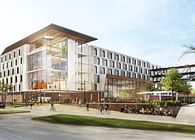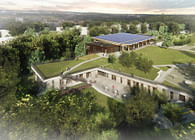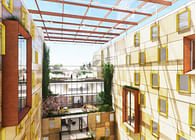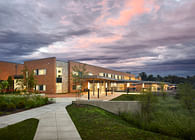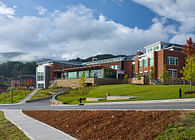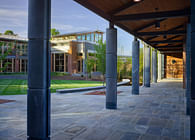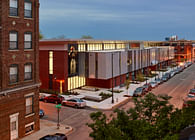
Charlottesville, VA | Washington, DC
The Greer Environmental Sciences Center elevates Virginia Wesleyan University’s commitment to environmental sustainability and advocacy for a thriving, cross-disciplinary sciences program. Occupying the last building location on the main quad, the Center acts as a portal for students—connecting them to the building’s dynamic program and natural context through a series of transparent layers and pathways brimming with native flora and fauna. The building creates an inspiring sense of place that sets a new standard for how the built environment can facilitate hands-on learning opportunities, catalyze regional research partnerships, and connect students to their purpose as stewards of their campus and its broader environmental context.
The Greer Center creates an immersive science experience for everyone on campus, not just science majors. The design stacks and centers the teaching labs within the building—and ties wayfinding, programmatic adjacencies, and visual proximities to the lab experience through fully-glazed quad-facing walls that put science on display. Instead of being tied to specific departments, the four teaching labs are organized thematically around the Earth’s four spheres (atmosphere, biosphere, hydrosphere, and geosphere). Adjacent to each teaching lab are research spaces designed to support specialized investigations. Carefully orchestrated transparency between key spaces allows students and faculty—whether in a lab, office, or even outdoors—to be connected to each other and to the life of the building.
Complementing the building’s programmatic transparency are interactive details that animate the LEED Gold building as a teaching tool. Educational signage explains the broad palate of sustainable materials while a building dashboard with real-time data visualizations allows students to track the effectiveness of the geothermal heat exchangers and photovoltaic panels. Sustainable features are accessible to students who study local flora and fauna and monitor the building’s use of energy and water. Vegetated bioretention basins offer habitats for birds and wildlife while treating rainwater and stormwater runoff in inventive and engaging ways. Through revealed natural and building systems, students develop awareness of the interconnections of natural systems, the importance of caring for local watersheds and animal habitats, and the responsibility to combat climate change in a region threatened with the imminent effects of sea level rise.
Building resources were developed specifically to leverage research opportunities between students and faculty, and with a network of environmental partners in the Chesapeake Bay region who now have a physical platform for partnering with the University. The building extends beyond its footprint to promote a campus culture of lifelong collaboration and interdisciplinary research—fulfilling the university’s liberal arts mission to engage a diversity of students in applied learning experiences.
Status: Built
Location: Virginia Beach, VA, US
Firm Role: Architect of Record
Additional Credits: Photography by Alan Karchmer
